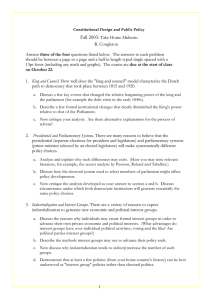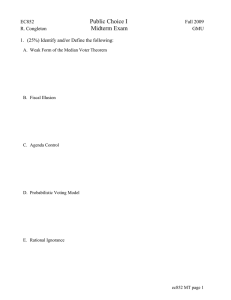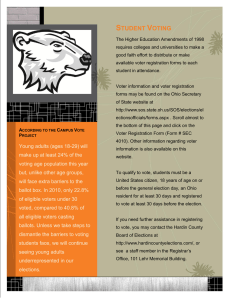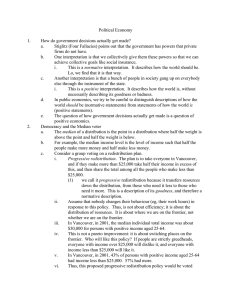I. Introduction: Choosing Environmental Regulations
advertisement
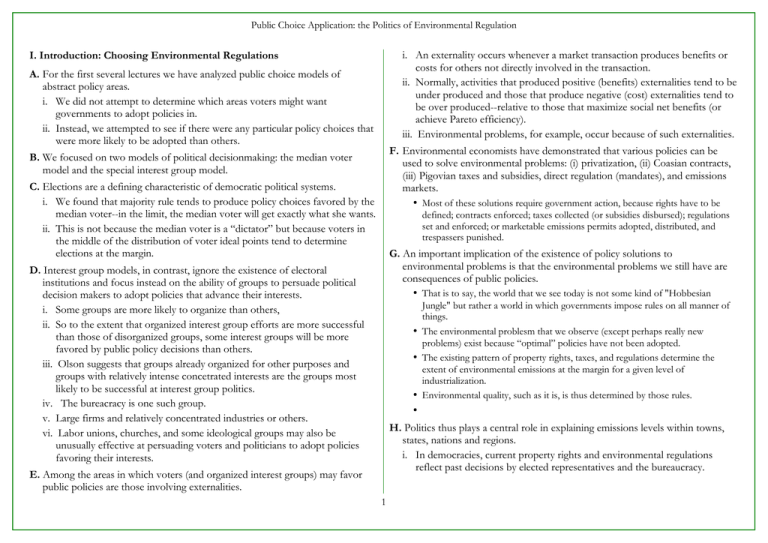
Public Choice Application: the Politics of Environmental Regulation i. An externality occurs whenever a market transaction produces benefits or costs for others not directly involved in the transaction. ii. Normally, activities that produced positive (benefits) externalities tend to be under produced and those that produce negative (cost) externalities tend to be over produced--relative to those that maximize social net benefits (or achieve Pareto efficiency). iii. Environmental problems, for example, occur because of such externalities. I. Introduction: Choosing Environmental Regulations A. For the first several lectures we have analyzed public choice models of abstract policy areas. i. We did not attempt to determine which areas voters might want governments to adopt policies in. ii. Instead, we attempted to see if there were any particular policy choices that were more likely to be adopted than others. F. Environmental economists have demonstrated that various policies can be used to solve environmental problems: (i) privatization, (ii) Coasian contracts, (iii) Pigovian taxes and subsidies, direct regulation (mandates), and emissions markets. B. We focused on two models of political decisionmaking: the median voter model and the special interest group model. C. Elections are a defining characteristic of democratic political systems. i. We found that majority rule tends to produce policy choices favored by the median voter--in the limit, the median voter will get exactly what she wants. ii. This is not because the median voter is a “dictator” but because voters in the middle of the distribution of voter ideal points tend to determine elections at the margin. w Most of these solutions require government action, because rights have to be defined; contracts enforced; taxes collected (or subsidies disbursed); regulations set and enforced; or marketable emissions permits adopted, distributed, and trespassers punished. G. An important implication of the existence of policy solutions to environmental problems is that the environmental problems we still have are consequences of public policies. D. Interest group models, in contrast, ignore the existence of electoral institutions and focus instead on the ability of groups to persuade political decision makers to adopt policies that advance their interests. i. Some groups are more likely to organize than others, ii. So to the extent that organized interest group efforts are more successful than those of disorganized groups, some interest groups will be more favored by public policy decisions than others. iii. Olson suggests that groups already organized for other purposes and groups with relatively intense concetrated interests are the groups most likely to be successful at interest group politics. iv. The bureacracy is one such group. v. Large firms and relatively concentrated industries or others. vi. Labor unions, churches, and some ideological groups may also be unusually effective at persuading voters and politicians to adopt policies favoring their interests. w That is to say, the world that we see today is not some kind of "Hobbesian Jungle" but rather a world in which governments impose rules on all manner of things. w The environmental problesm that we observe (except perhaps really new problems) exist because “optimal” policies have not been adopted. w The existing pattern of property rights, taxes, and regulations determine the extent of environmental emissions at the margin for a given level of industrialization. w Environmental quality, such as it is, is thus determined by those rules. w H. Politics thus plays a central role in explaining emissions levels within towns, states, nations and regions. i. In democracies, current property rights and environmental regulations reflect past decisions by elected representatives and the bureaucracy. E. Among the areas in which voters (and organized interest groups) may favor public policies are those involving externalities. 1 Public Choice Application: the Politics of Environmental Regulation ii. In dictatorships, the regulations reflect the past decisions of dictators and the bureaucracy. iii. However, neither an elected government, nor a dictator, can simply adopt any policy that it wants. All durable governments operate under various institutional constraints. II. A Quick Review of Majority Rule and the Median Voter A. From the rational choice perspective, voters, elected representatives, and bureaucrats should all be assumed to be self-interested in the same sense that consumers and firms are in the private sector. i. That is to say, given the opportunities before them, individuals in the "political sector" are assumed to maximize their own net advantages (net benefits or utility) given the constraints that they face. ii. Consequently, if one wishes to understand the pattern of existing environmental policies, one has to take account of the interests and incentives faced by voters and by government agents. I. Most elected officials wish to win the next election. To do that elected officials have to pick policies that will please a majority of the voters more than policies proposed by its future rivals for office. i. Even dictators require some level of support--often chiefly among top mililtary and police officials--to continue in office. ii. Within democracies (and some dictatorships) there are also constitutional constraints on the types of policies that can be put in place. B. Although a wide variety of decision making procedures are used within democratic governments, we will focus our attention on one that is central to the nature of democratic governance, namely majority rule. i. There are of course many other voting rules besides majority rule: ii. Unanimity (Unanimity requires 100% approval is required to pass a new law. Some laws passed by the EU are adopted via unanimity at the level of government representatives. Under that rule, anyone can veto a new law.) iii. Super Majority (More than 50% approval is required to pass new laws. This is required for constitutional amendments and impeachment under the US constitution. It also seems to be an implicit rule within the US Senate.) iv. One person rule (Commander in Chief, Executive Mandates) v. (The first analytical examination of which voting rules work best for a given circumstance was undertaken in: The Calculus of Consent, 1962, by James M. Buchanan and Gordon Tullock.) vi. (For a more complete treatment of democratic politics, you should take a complete course in public choice.) w The "takings clause" makes most constitutional government pay for goods and services taken from individual citizens. w The "equal protection" laws imply that a law should not treat different groups differently. That is to say, laws have to be based on general principles: all firms with characteristic F are subject to environmental regulation R. J. Today’s lecture focuses on the politics of environmental choice within democracies. We will focus mainly on the electoral constraint faced by representatives. i. Electoral competition plays a very important role in determining policy at the margin. ii. One can not simply assume that environmental policy is made by some net-benefit maximizing all knowing environmental agency, as sometimes seems to be implied by environmental economics text books. iii. Rather, environmental policies are political choices that are made by senior policy makers. iv. Political and legal institutions create incentives for elected officials to behave in particular ways on evironmental policies--namely if they want to be reelected, they have to adopt polices that please a majority of voters.. C. The most widely used model of majoritarian politics is the median voter model. w In a variety of electoral settings, self interested behavior implies that the "median voter" will get his or her way. w There are, as developed below, strong and weak versions of the median voter model. 2 Public Choice Application: the Politics of Environmental Regulation w In the example above Bob's preferred expenditure level, $10, will defeat any other policy. w Note that the median voter's ideal point (10 in the example) can beat every other possible alternative in pair-wise voting. D. For example, suppose that three individuals: Al, Bob and Cathy are to make a decision about where to eat lunch based on majority rule. i. Al prefers a restaurant where lunch can be had for $5.00, Bob wants one where lunch costs around $10.00 and Cathy, a gourmet, prefers one costing around $20.00. ii. For convenience assume that, given any two options, each will prefer the restaurants whose price for lunch that is closest to their preferred one. iii. (This "spatial voting" model results whenever voter marginal benefit and marginal cost curves are approximately straight lines.) iv. Consider some votes on various alternative spending levels: Options Votes Cast III. Electoral Competition and The Median Voter A. The previous illustration shows that the median voter determines the electoral outcome in direct elections. We now show that the median voter is also very important in representative democracy. B. To make our analysis of elections more straight forward, we will assume that Voters all vote for the candidate (or policy) that is "closest" to them in the policy dimension. Outcome w $10 vs. 20$ A: 10 B: 10 C: 20 10 MP 20 w $5 vs. $20 A: 5 B: 5 C: 20 5 MP 20 w $5 vs. $16 A: 5 B: 5 C: 16 5 MP 16 w $10 vs. $5 A: 5 B: 10 C: 10 10 MP 5 w $12 vs. 10 A: 10 B:10 C: 12 10 MP 12 C. This assumption allows competition between candidates for government office can be analyzed with a diagram that shows the distribution of voter ideal points. i. The distribution of voter ideal points can be used to form diagram with policy alternatives along the bottom (X) axis and with number of voters with a specific ideal point along the vertical axis. ii. The area under the resulting curve gives you a number of voters. E. Note that Bob always votes in favor of the outcome that actually wins the election. (The B column of votes and the Outcome column are EXACTLY the same.) Election Between Candidate C1 and C2 ( C2 wins ) Number of Voters F. Note also that exactly the same number of individuals prefer a more expensive dinner as prefer a less expensive dinner than Bob. In this case, one each. (This is the definition of a median ideal point or "preference.") w Thus, Bob is the median voter. (He is the voter with the median ideal point.) G. The Weak Form of the median voter theorem says that the median voter always casts his vote for the policy that is adopted. w The weak form nearly always is true under majority rule voting between two alternatives. w In the example above, Bob always votes with the majority. Votes C1 Votes C2 V H. The Strong Form of the median voter theorem say the median voter always gets his most preferred policy. C2 C1 Indifferent Voter 3 Median Voter Policie/Voter Ideal Points Public Choice Application: the Politics of Environmental Regulation w That is to say the strong from of the median voter theorem holds at the Nash equilibrium of the election game! iii. The assumption of spatial voting allows us to determine how all these voters will vote when there are two candidates or two policy options being voted on iv. (That is to say, every voter will vote in favor of the candidate whose position is closed to their own.) Note that voters who are exactly half way between the two "alternatives" will be indifferent between them. v. Voters to the left of the indifferent voters will vote for the policy on the left, and those to the right of the indifferent voter will vote for the policy on the right. ) IV. The Median Voter and Environmental Policy A. One important implication of the strong form of the median voter model is that the benefit and cost of environmental programs to the median voter ultimately determines a democratic nation’s environmental policies. w Other factors, such as interest groups, may also matter. w But as long as electoral pressures push members of Congress and the President, or Reischstag and Chancellor, median voter interests will remain on their minds. D. The illustration above assumes that candidates 1 and 2 have taken positions and that voters vote for the candidate closest to their ideal point. i. The distribution of voter ideal points is assumed to be a "uniform" distribution to simplify the diagram--other distributions are of course possible. ii. Given these positions, it turns out that Candidate C1 loses this election. iii. How could he or she have done better? Clearly he or she should have chosen a policy position further to the right--one that is closer to the median voter. B. The median voter is approximately the VOTER with MEDIAN characteristics. i. That is to say, he or she is a voter of median age with median income, median education, median family size, median political ideas and so forth. ii. Note that the median voter will not ordinarily be the median member of the community, because not all persons are equally likely to vote! w In the US it turns out that the median voter is a bit older, richer, and better educated than the median member of the group of persons eligible to vote. w Poor, young, and less educated person vote less frequently than older, richer, and more educated persons. w As a first approximation, the median voter of the U. S. is a middle aged woman with one or two children and a bit of college education (remember the soccer moms). E. It turns out that the candidate who is closest to the median voter's ideal point will always win the election, because that voter will always receives AT LEAST HALF OF THE VOTES. w Thus, if candidates are free to adjust their policy position to attract votes, they will each try to be closer to the Median Voter's ideal point than the other candidate. iii. On environmental issues, ideology (greenness) and risk aversion will also be determinant of “who” the median voter is. F. In equilibrium, this kind of competition for votes implies that both candidates will take essentially the same position, namely that of the median voter. i. If candidates take approximately the same position, they will receive approximately the same number of voters. So the median voter model predicts close elections. ii. At the equilibrium, the median voter model also implies that the median voter gets exactly what he or she wants. C. To the extent that the Median Voter gets what he or she wants, anything that changes the median voter's preferred policy will affect government policy. i. This prediction assumes that competition for office is fairly intense, and also neglects possible "agency problems." w For example, candidates may say one thing to get elected and do something else once in office. 4 Public Choice Application: the Politics of Environmental Regulation w Moreover, elected representatives may not be able to fully control the bureaucracy. i. Modeling median voter preferences for such services is fairly straight forward, once you know how the cost of the service will be shared among tax payers. ii. A convenient assumption (at least for diagrams) is to assume that everyone pays roughly the same price, 1/N of the total MC of providing the service. ii. Candidates that are known to have cheated and done poorly at overseeing the bureaucracy, however, should be more likely to lose the next election than those that have not since the median voter will not have gotten what he or she wants. w This creates incentives for elected policy members to monitor the bureaucracy and encourage the “right” policies to be adopted. w So the assumption that policies are fundamentally driven by elections and voter interests is not a crazy assumption. E/$ SMB = MBa+MBb+MBc MBc SMC = MCa+MCb+MCc = 3*MC D. To the extent that government services are normal goods, Government services will tend to increase as the median voter becomes wealthier, as their tax-cost relative to private services decreases, and as their perceived value increases. MBb MBa MC=MCa=MCb=MCc w Environmental policies are evidently a superior good, that voters prefer more of as their income increases. 0 E. To the extent that a policy area is partly determined by perceptions of risks, events that change the perceived risks of some policy area will change the demand for policies in that area. Ea Eb Ec Eo E Environmental Quality E** Voting for Environmental Quality Standards (Note that the median voter is Bob (b), who prefers somewhat greater environmental quality than is Pareto efficient, Eb > E**) w Environmental policies are, evidently, partly determined by the perceived risks associated with various environmental externalities. F. To the extent the a policy area is affected by ideology or visions of the good society, changes in the median voter’s beliefs will also affect policy choices. iii. For example consider the figure above, the costs of providing environmental quality (say water purity) are shared equally, which allows one to figure out each voter’s preferred level of environmental quality (or water treatment plant size). w Environmental policies are, evidently, partly determined by “greenness” of the median voter. V. An Illustration of the Democratic Politics of Environmental Regulation w The median voter is “b” who prefers Eb, given his/her marginal benefits and costs. w Note that in the diagram shows that the median voter’s preferred policy is not necessarily Pareto efficient. A. In some cases, government policies directly produce environmental quality as with water plants and sewage treatment plants. In such cases, there are economies of scale to providing the service that make collective provision cost effective. iv. (It turns out that assumptions about how the costs are shared can have significant effects on the predicted median voter outcome.) 5 Public Choice Application: the Politics of Environmental Regulation B. The median voter's optimal degree of regulation is a bit different than that regarding ordinary government services because the cost of regulation is always indirect. w There is no "direct" tax bill for regulations, rather regulations indirectly increase the cost of other valued goods and services. $/Q quasi-Pigovian Tax (required to obtain Q*b) SMC = MCind + MCext C. In the case of environmental regulation, i. Every voter receives direct benefits from more stringent environmental regulation: cleaner air, improved health, more pleasant environment, more attractive outdoor life styles and so forth, ii. and every voter also pays a "price" for that clearer air, although the cost of environmental regulation is very indirect. iii. However, one can think about mandated equipment, for example, in a manner similar to a tax. Supply = MCind lost CS P* lost profit MCext Demand w Mandated equipment tends to raise prices and reduce profits, in a manner that is somewhat similar to a Pigovian tax, but without generating any revenue. w Mandated equipment includes catalytic converters for cars and scrubbers for coal fired power plants, etc. w (In the mandate case, it is theoretically appropriate to model the effects by shifting supply to the left, rather as a tax, but a “pseudo-tax” diagram allows you to get a sense of the distribution of burdens and benefits from mandated equipment. In this case the “tax revenue” is money that goes to the producers of “environmentally friendly” equipment.) w The distribution of benefits and costs will provide incentives to vote in favor or against the mandated equipment (and also to lobby in favor of or against the mandated piece of equipment). Q*b Q** Q* Q Output of goods in the regulated market(s) v. Many of the effects of such regulations are indirect ones that affect the costs of other products that are not directly regulated. w For example, an environmental tax on gasoline and fuel oil, makes products that have to be transported to market relatively more expensive. w Pollution control devices (usual) increase the cost of manufactured goods. w In such cases, the marginal cost of increased environmental quality shows up as an increase in the price of manufactured goods and large transported goods relative to other less energy-intensive products. iv. Similarly, one can analyze incentives to favor a Pigovian tax by using the diagram to think about who “wins” and who “loses” from a particular Pigovian tax solution. vi. Once one can estimate the typical marginal cost of an environmental regulation, once can model voting behavior using the usual net-benefit maximizing model of human behavior that we have used throughout the course. w (Note that both firms and consumers in the taxed industry are made worse off.) 6 Public Choice Application: the Politics of Environmental Regulation w There are "political" externalities as well as environmental ones. w (Remember we assuming self-interested voting.) iv. In the illustration above, Q** differs from Q*b. $/E w Namely, Q** > Q*b Voting on Environmental Regulation w However, cases also exist in which Q** < Q*b (draw such a case). v. What does this imply about environmental regulation in a democracy? SMB VI. Connecting the Political and Market Analyses Marginal Cost ( Increase in prices of non-environmental goods ) Q*c Q*b Q** B. Assume that their marginal benefit curves are those illustrated below, and that they all face the same marginal cost curve for environmental quality. i. Differences in their MB curves may, for example, income differences, because they all agree about the optimal level of environmental quality when it costs nothing to obtain, namely Q0. ii. The assumption that their marginal costs are similar implies that they all consume similar amounts of the final goods whose prices will be affected by environmental regulation. iii. Their marginal cost of environmental quality is reduced consumer surplus from the higher prices in the regulated markets caused by taxes, changes in production methods, or charges for producing regulated effluents. MBal MBbob MBcathy A. Suppose that three voters (or three types of voters) exist, and are attempting to determine environmental quality in some potential area of public policy: air pollution, water pollution, etc. Q*a EQ, Stingency of Envoronmental Regulation D. Illustration of voting for environmental regulations (see the diagram above): i. Assume that three voters have different tastes for environmental quality but have similar tastes for non-environmental goods. w This allows the figure above to be used to characterize the MC of environmental regulation with the same curve, w and the MB from environmental regulation to be characterized by their individual curves w Note that Bob is the median voter. (Why?) C. Note that the environmental quality level demanded by the median voter (Bob), in this case, is quite close to that which maximizes social net benefits, but is a bit larger than that which maximizes social net benefits. D. In the regulated market, this implies that the corresponding quasi-Pigovian tax is greater than that which we analyzed earlier in the course, because the median voter demands somewhat more stringent regulations than required to maximize social net benefits (to achieve the Pareto efficient level of environmental quality), Q*b > Q**. ii. The median voter model, thus, implies that government will adopt policy Q*b. iii. Notice, however, that the median voter's ideal point is not necessarily the same as the Pareto efficient level of regulation, because Bob has no reason to take account of the benefits and costs imposed on other voters. 7 Public Choice Application: the Politics of Environmental Regulation i. Note that if the voters have calculated their marginal costs correctly, that their lost consumer surplus (in the second figure) has been taken account of by each of the voters when choosing their ideal environmental quality levels. ii. Their marginal benefits from increased environmental quality show up in the second diagram as reductions in the marginal external costs. (Each voter bears some fraction of the reduced consumer supplus--one consumer's worth--and gains some fraction of the reduced external costs.) ii. Also, consider the case in which all pay for the regulation, because all consume the regulated goods, but only a single voter (minority of voters) benefits from the regulations (because only a minority of voters live down stream or downwind from the factories where this product is produced). w Will the median voter prefer too much or too little in this case? w Not every regulation improves efficiency. w There can be" government failures" as well as "market failures." iii. What do these concentrated benefit (or cost) examples imply about the types of pollution that will be regulated in a well-functioning democracy? E. Given the assumptions of the first diagram (the electoral one), the median voter presses for somewhat more stringent regulation than is Pareto efficient, and is willing to pay the price of the regulation (his or her reduced consumer surplus from higher taxes. i. The assumption that all voters benefit from the policy and all pay similar costs implies that the final result (regulatory system, T) is just what they had in mind. ii. Not that in this case that the tax is a bit too high, but that the result is not so far from the Pareto Efficient outcome. VII. Interest Groups, Persuasion and Environmental Policy A. Although we do not have time to do a thorough treatment of the effects of interest groups, this should not be taken to mean that their effects or negligible. B. Both "brown" (industrial) and "green" (environmentalist) groups often support persuasive campaigns that attempt to persuade voters that environmental policies are too stringent or too lax. F. Of course, the assumptions of the first diagram, that all voters benefit from reduction in the externality and all are consumers of the regulated products are often true, but not always true. i. In some cases, however, the benefits and costs of pollution control are concentrated. w The success of Green persuasive campaigns over the past fifty years is obvious, both in policies and in the treatment of environmental issues in newspapers, blogs, and within public schools. C. It also bears noting that the bureaucracy also sometimes launch persuasive campaigns designed to influence voters and thereby elected representatives. w That is to say, in some cases, only a small fraction of voter receive all or most of the benefits of regulations. w While in others, the cost of paying for the service may be borne by only a small subset of the electorate. w Bureaucrats also have significant incentives to lobby for higher budgets (Niskanen model), which may also influence the kinds of policies that environmental agencies tend to recommend. w In particular the Niskanen model implies that bureaucrats have incentives (both private and public interest) in the size of their budgets. As a consequence, he argues that bureaucrats attempt to maximize their budgets. w In the environmental policy area, this implies that environmental agencies will make proposals and provide information (about benefits, risks, costs, and options) that they believe will increase the size of their budgets. G. In other cases in which the benefits or costs of environmental regulation are concentrated among fairly narrow minorities, the median voter may prefer levels of regulation that are quite far from the Pareto efficient level. i. As an exercise, draw a case in which all voters benefit from the regulation, but one voter pays a positive price for environmental regulation and the others pay nothing (because they do not consume the regulated product). Will the median voter prefer too much or too little in this case? 8 Public Choice Application: the Politics of Environmental Regulation w This, for example, tends to create a bias in the kinds of environmental risk assessments that they publish. (They have incentives to emphasize new risks rather than past successes.) w It also may cause them to favor environmental policy methods that have relatively high administrative costs associated with them--higher ones than associated with other policy instruments. w (In Niskanen’s model, bureaucrats use their expertise and superior information to bargain with Congress for regulatory authority and larger budgets. Of course, Congress should recognize what is going on and take this into account when assessing what the agency tells them about alternative policies.) w For example, in the various international environmental treaties, countries agree to strengthen various environmental regulations to deal with an international externality. w State and local governments may negotiate with each other and sign agreements to coordinate policies or to create a "special use district" of the same "size" as the externality. (Examples include airport and transit authorities (NY, NJ and CN) and water commissions (US and Canada, Sweden and Denmark) etc. D. Another solution possible within a country is to "ask" higher levels of government to regulate the matter of concern. w Adjacent counties may ask states to regulate "county externalities," states may ask the federal government to regulate "inter state externalities." w In Europe the regulation of many international externalities is coordinated by the European Community. D. (We will return to the effects of interest groups on public policies later in the course if there is time.) VIII. Regulatory Externalities between Governments: Majority Rule, Federalism, and International Treaties w The results of these methods may well be highly imperfect (relative to Pareto optimality) for several reasons. Discuss some of these. A. Some environmental problems are too large for a single elected government to address by itself. w Is there a free riding problem among governments? B. That is to say, there are many real-world cases in which even if a "local" government attempted to achieve a Pareto efficient outcome locally, it cannot actually achieve Pareto optimal results, because part of the problem is generated by persons or companies outside their jurisdiction. i. In such cases, regulation itself can be an externality generating activity. w That is to say regulations in one state may impose benefits or costs on resident of other adjacent jurisdictions. ii. Consequently, there may be unrealized gains to trade between governments regarding appropriate regulation. w In a median voter model, the median voters of neighboring local governments would have reasons to coordinate their policy choices. C. There are basically two common methods for addressing such externality problems. i. First, the affected parties may attempt to negotiate a "Coasian" contract that "internalizes" the regulatory externality. That is to say, the governments may negotiate a treaty in which the countries or states "trade regulations." 9
